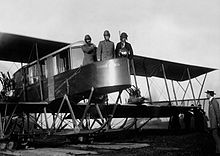Russky Vityaz
| Sikorsky Russky Vityas | |
|---|---|

|
|
| Type: | Passenger plane |
| Design country: | |
| Manufacturer: | |
| First flight: |
May 13, 1913 |
| Commissioning: |
- |
| Production time: |
1912/1913 |
| Number of pieces: |
1 |
The Russian Sikorsky Russki Witjas ( Russian Русский витязь , "Russian warrior ", also Le Grand ) from 1913 is considered one of the milestones in aviation history. It was the first four-engine aircraft in the world and the first purely passenger aircraft .
development
The Russki Witjas was built by Igor Ivanovich Sikorski . When he began planning the aircraft in 1911, no aircraft could carry more than 600 kg. The record was held by the French pilot Ducis, who carried out an 800 m flight with this load. When the world learned of the construction of the Russky Vityaz in early 1913, the experts and the press believed that this machine could never fly.
Despite the expert opinion, the Russki Vitjas flew for the first time on May 13, 1913 in Saint Petersburg with the pilots Sikorsky and Aleknowitsch.
The first version still had the two 100 HP Argus in-line engines connected in series, which drove two pull propellers. Sikorski, however, was dissatisfied with the performance and converted the aircraft to four propellers. The aircraft was first flown in this configuration on July 23, 1913.
The Russki Witjas was a very large double-decker with a wingspan of 27 meters, which was built from spruce, pine and ash wood. The wings were covered with mahogany plywood and linen fabric. The aircraft had a 5.75 meter long and 1.85 meter wide cabin for the pilot and passengers. The passenger cabin was luxuriously furnished with four seats, a sofa, a table, electric lights and a washroom. Passengers were allowed to walk around during the flight without endangering stability. In front of the pilot's cabin there was an observation stand with a searchlight and a machine gun stand. The aircraft had 16 wheels, four large runners and needed a take-off distance of around 700 m to take off.
On August 2, 1913, the Russki Witjas achieved a best performance when she was loaded with seven passengers and remained in the air for an hour and 54 minutes. In total, the Russki Vitjas made 53 flights without an accident. However, the wing of the machine was badly damaged on September 11, 1913 on the runway of the Krasnoye Selo airfield when a Voisin biplane lost its engine in flight. Sikorski then decided to dismantle the machine and build a new aircraft, the Ilya Muromets . This later became the world's first four-engine bomber .
Technical specifications

| Parameter | Data |
|---|---|
| crew | 3 |
| Passengers | 5 |
| length | 20.00 m |
| span | above 27.00 m below 20.00 m |
| height | 4.00 m |
| Wing area | 120 m² |
| Empty mass | 3400 kg |
| Takeoff mass | normal 4000 kg maximum 4940 kg |
| Wing loading | 35.0 kg / m² |
| drive | four Argus in-line engines; 100 HP (74 kW) each |
| Power load | 10.5 kg / hp |
| Top speed | 90 km / h |
| Landing speed | 70 km / h |
| Service ceiling | 600 m |
| Range | 170 km |
| Armament | a MG |
literature
- Heinz AF Schmidt: Soviet planes . Transpress, Berlin, p. 33 .